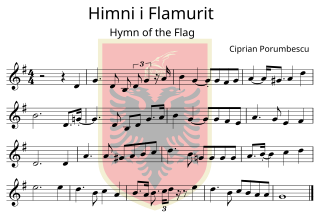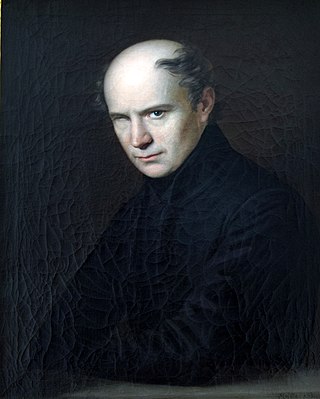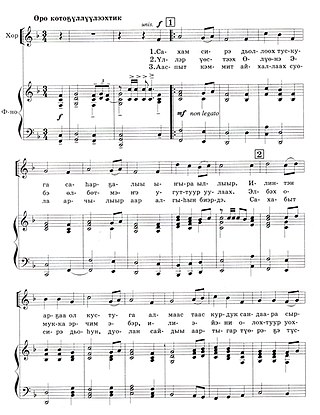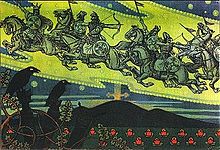
"Himnusz" is the national anthem of Hungary. The lyrics were written by Ferenc Kölcsey, a nationally renowned poet, in 1823, and its currently official musical setting was composed by the romantic composer Ferenc Erkel in 1844, although other less-known musical versions exist. The poem bore the subtitle "A magyar nép zivataros századaiból" ; it is often argued that this subtitle – by emphasising past rather than contemporary national troubles – was added expressly to enable the poem to pass Habsburg censorship. The full meaning of the poem's text is evident only to those well acquainted with Hungarian history. The first stanza is sung at official ceremonies and as well in common. It was de facto used as hymn of the Kingdom of Hungary from its composition in 1844, and was officially adopted as national anthem of the Third Hungarian Republic in 1989.

"Himni i Flamurit" is the national anthem of Albania, adopted in 1912. Its music is derived from the Romanian patriotic song "Pe-al nostru steag e scris Unire", composed by Ciprian Porumbescu. The lyrics, which are close to the original Romanian lyrics, were written by Albanian poet Asdreni. The anthem was originally titled "Betimi mbi Flamur".

Odorheiu Secuiesc is the second largest municipality in Harghita County, Transylvania, Romania. In its short form, it is also known as Odorhei in Romanian and Udvarhely in Hungarian. The Hungarian name of the town "Udvarhely" means "courtyard place".

The Székelys, also referred to as Szeklers, are a Hungarian subgroup living mostly in the Székely Land in Romania. In addition to their native villages in Suceava County in Bukovina, a significant population descending from the Székelys of Bukovina currently lives in Tolna and Baranya counties in Hungary and certain districts of Vojvodina, Serbia.

The Csángós are ethnic Hungarians of Roman Catholic faith living mostly in the Romanian region of Moldavia, especially in Bacău County. The region where the Csángós live in Moldavia is known as Csángó Land. Their traditional language, Csángó, a Hungarian dialect, is currently used by only a minority of the Csángó population group.

The Szózat is a Hungarian patriotic song. De facto, it is regarded as "the second national anthem" of Hungary, beside the Himnusz, which is a constitutionally defined state symbol.

The Székely Land or Szeklerland is a historic and ethnographic area in present-day Romania, inhabited mainly by Székelys, a subgroup of Hungarians. Its cultural centre is the city of Târgu Mureș (Marosvásárhely), the largest settlement in the region.
The "Rákóczi March", sometimes known as the "Hungarian March" was one of the unofficial state anthems of Hungary before Ferenc Kölcsey wrote the Himnusz. It was most likely composed by Nikolaus Scholl in 1820. The melody later used in many famous compositions, most notably: La damnation de Faust and Hungarian Rhapsody No. 15.

Ferenc Kölcsey was a Hungarian poet, literary critic, orator, and politician, noted for his support of the liberal current in Hungary regarding the politics involving the Austrian Empire. He wrote Himnusz, the national anthem of Hungary in 1823.

The Székely Land (Szeklerland) is a historic and ethnographic region in Eastern Transylvania, in the center of Romania. The primary goal for the Hungarian political organisations in Romania is to achieve Székely autonomy. The Szeklers make up about half of the Hungarians in Romania and live in a compact ethnic bloc. According to official data from Romania's 2011 census, 609,033 persons in Mureș, Harghita, and Covasna counties consider themselves Hungarian. The Székelys (Szeklers), a Hungarian sub-group, are mainly concentrated in these three counties.

Benedek Elek was a Hungarian journalist and writer, widely known as "The Great Folk-Tale Teller" of The "Szekely Hungarian" Fairy-Tales.

The state anthem of the Sakha Republic is the regional anthem of the Sakha Republic, a federal subject of Russia. It is one of the official symbols of the Sakha Republic, along with the flag and the coat of arms of the Sakha Republic. It was originally written in the Yakut language by Savva Tarasov and Mikhail Timofeyev. The anthem was translated into Russian by Vladimir Fedorov. The music was composed by Kirill Gerasimov. It was officially adopted on 15 July 2004. The anthem's music is played in F major.
The Szekler Sabbatarians were a religious group in Transylvania and Hungary between the sixteenth and nineteenth centuries who held Unitarian and judaizing beliefs.
Attila György, is a Székely writer, journalist, and literary editor. He has received the Attila József Prize for excellence in Hungarian literature.
Kálmán Mihalik was a Hungarian physician and composer, best known for setting the music of the Székely Himnusz.
György Csanády was a Hungarian poet, journalist and radio director of Székely origins. He is the author of Székely himnusz.
Scholarly theories about the origin of the Székelys can be divided into four main groups. Medieval chronicles unanimously stated that the Székelys were descended from the Huns and settled in the Carpathian Basin centuries before the Hungarians conquered the territory in the late 9th century. This theory is refuted by most modern specialists. According to a widely accepted modern hypothesis, the Székelys were originally a Turkic people who joined the Magyars in the Pontic steppes. Another well-known theory states that the Székelys are simply Magyars, descended from the border guards of the Kingdom of Hungary who settled in the easternmost region of the Carpathian Basin and preserved their special privileges for centuries. According to a fourth theory, the Székelys' origin can be traced back to the Late Avar population of the Carpathian Basin.

The Apor family is a family of ancient Hungarian nobility, which played a major role in Transylvanian history. It has several branches, which held different ranks over the years, including primor, and the Westernised titles of báró (baron) and gróf (count).

The flag of the Székelys is the flag used by the ethnic Hungarian Székely community of Romania. It is a blue flag with a golden strip and a "sun-star" and crescent moon, both perceived as ancient Székely symbols. Being designed by Ádám Kónya, the Szekler National Council adopted it in 2004 and is since then a symbol for the Székely people. The Romanian authorities have imposed some restrictions on under which conditions may the flag be displayed, which has allegedly fostered its popularity.

The coat of arms of the Székelys is the coat of arms used by the Hungarian Székely community of Romania. It is a blue coat of arms with a golden eight-pointed "sun-star" and a silver crescent moon, both perceived as ancient Székely symbols. Being designed by Ádám Kónya, the Szekler National Council adopted it in 2004 and is since then a symbol for the Székely people.













